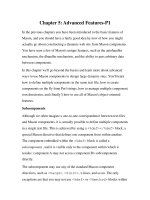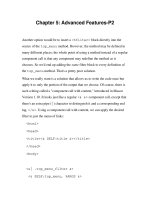Chapter 5 v7 01
Bạn đang xem bản rút gọn của tài liệu. Xem và tải ngay bản đầy đủ của tài liệu tại đây (3.01 MB, 88 trang )
©1996-2016, J.F Kurose and K.W. Ross
Computer Networks
Lectured by:
Nguyen Le Duy Lai
()
Computer
Networking: A Top
Down Approach
7th Edition, Global Edition
Jim Kurose, Keith Ross
Pearson
April 2016
Network Layer: The Control Plane
5-1
©1996-2016, J.F Kurose and K.W. Ross
Chapter 5
Network Layer:
The Control Plane
Computer
Networking: A Top
Down Approach
7th Edition, Global Edition
Jim Kurose, Keith Ross
Pearson
April 2016
Network Layer: Control Plane 5-2
Chapter 5: network layer control plane
©1996-2016, J.F Kurose and K.W. Ross
chapter goals: understand principles behind network
▪
▪
▪
▪
control plane
traditional routing algorithms
SDN controllers
Internet Control Message Protocol (ICMP)
network management
and their instantiation, implementation in the Internet:
• OSPF, BGP
• OpenFlow, ODL and ONOS controllers
• ICMP, SNMP
Network Layer: Control Plane 5-3
©1996-2016, J.F Kurose and K.W. Ross
Chapter 5: outline
5.1 introduction
5.2 routing protocols
▪ link state
▪ distance vector
5.3 intra-AS routing in the
Internet: OSPF
5.4 routing among the ISPs:
BGP
5.5 The SDN control plane
5.6 ICMP: The Internet
Control Message
Protocol
5.7 Network management
and SNMP
Network Layer: Control Plane 5-4
Network-layer functions
Recall: two network-layer functions:
©1996-2016, J.F Kurose and K.W. Ross
▪ forwarding: move packets
from router’s input to
appropriate router output
▪ routing: determine route
taken by packets from source
to destination
data plane
control plane
Two approaches to structuring network control plane:
▪ per-router control (traditional)
▪ logically centralized control (software defined networking)
Network Layer: Control Plane 5-5
Per-router control plane
Individual routing algorithm components in each and every
router interact with each other in control plane to compute
forwarding tables
©1996-2016, J.F Kurose and K.W. Ross
Routing
Algorithm
control
plane
data
plane
Network Layer: Control Plane 5-6
Logically centralized control plane
A distinct (typically remote) controller interacts with local
control agents (CAs) in routers to compute forwarding tables
Remote Controller
©1996-2016, J.F Kurose and K.W. Ross
control
plane
data
plane
CA
CA
CA
CA
CA
Network Layer: Control Plane 5-7
©1996-2016, J.F Kurose and K.W. Ross
Chapter 5: outline
5.1 introduction
5.2 routing protocols
▪ link state
▪ distance vector
5.3 intra-AS routing in the
Internet: OSPF
5.4 routing among the ISPs:
BGP
5.5 The SDN control plane
5.6 ICMP: The Internet
Control Message
Protocol
5.7 Network management
and SNMP
Network Layer: Control Plane 5-8
Routing protocols
©1996-2016, J.F Kurose and K.W. Ross
Routing protocol goal: determine “good” paths
(equivalently, routes), from sending hosts to
receiving host, through network of routers
▪ path: sequence of routers that packets will
traverse in going from given initial source host to
given final destination host
▪ “good”: least “cost”, “fastest”, “least congested”
▪ routing: a “top-10” networking challenge!
Network Layer: Control Plane 5-9
Graph abstraction of the network
5
2
u
2
1
©1996-2016, J.F Kurose and K.W. Ross
graph: G = (N,E)
v
x
3
w
3
1
5
z
1
y
2
N = set of routers = { u, v, w, x, y, z }
E = set of links ={ (u,v), (u,x), (v,x), (v,w), (x,w), (x,y), (w,y), (w,z), (y,z) }
aside: graph abstraction is also useful in other network contexts (e.g., P2P,
where N is set of peers and E is set of TCP connections)
Network Layer: Control Plane 5-10
Graph abstraction: costs
5
2
u
2
1
©1996-2016, J.F Kurose and K.W. Ross
v
x
3
w
3
1
c(x,x’) = cost of link (x,x’)
e.g., c(w,z) = 5
5
z
1
y
2
cost could always be 1 (hop count),
or inversely related to bandwidth,
or inversely related to congestion
cost of path (x1, x2, x3,…, xp) = c(x1,x2) + c(x2,x3) + … + c(xp-1,xp)
key question: what is the least-cost path between u and z?
routing algorithm: algorithm finds that least cost path
Network Layer: Control Plane 5-11
©1996-2016, J.F Kurose and K.W. Ross
Routing algorithm classification
Q: global or decentralized
information?
global:
▪ all routers have the complete
topology, link cost info
▪ “link state” algorithms
decentralized:
▪ router knows physicallyconnected neighbors, link costs
to neighbors
▪ iterative process of
computation, exchange of
info with neighbors
▪ “distance vector” algorithms
Q: static or dynamic?
static:
▪ routes change slowly over
time
dynamic:
▪ routes change more
quickly
• periodic update in
response to link cost
changes
Network Layer: Control Plane 5-12
©1996-2016, J.F Kurose and K.W. Ross
Chapter 5: outline
5.1 introduction
5.2 routing protocols
▪ link state
▪ distance vector
5.3 intra-AS routing in the
Internet: OSPF
5.4 routing among the ISPs:
BGP
5.5 The SDN control plane
5.6 ICMP: The Internet
Control Message
Protocol
5.7 Network management
and SNMP
Network Layer: Control Plane 5-13
A link-state routing algorithm
Dijkstra’s algorithm
▪ net topology, link costs
known to all nodes
â1996-2016, J.F Kurose and K.W. Ross
ã accomplished via link state
broadcast”
• all nodes have same info
▪ computes least cost paths
from one node (‘source”)
to all other nodes
• gives forwarding table for
that node
▪ iterative: after k
iterations, know least cost
path to k destinations
notation:
▪ c(x,y): link cost from
node x to y; = ∞ if not
direct neighbors
▪ D(v): current value of
cost of path from source
to destination v
▪ p(v): predecessor node
along path from source
to destination v
▪ N': set of nodes whose
least cost path
definitively known
Network Layer: Control Plane 5-14
©1996-2016, J.F Kurose and K.W. Ross
Dijsktra’s algorithm
1 Initialization:
2 N' = {u}
3 for all nodes v
4
if v adjacent to u
5
then D(v) = c(u,v)
6
else D(v) = ∞
7
8 Loop
9 find w not in N' such that D(w) is a minimum
10 add w to N'
11 update D(v) for all v adjacent to w and not in N' :
12
D(v) = min( D(v), D(w) + c(w,v) )
13 /* new cost to v is either old cost to v or known
14 shortest path cost to w plus cost from w to v */
15 until all nodes in N'
Network Layer: Control Plane 5-15
Dijkstra’s algorithm: example (1)
D(v), D(w), D(x), D(y), D(z),
Step
©1996-2016, J.F Kurose and K.W. Ross
0
1
2
3
4
5
N'
u
uw
uwx
uwxv
uwxvy
uwxvyz
p(v)
7,u
6,w
6,w
p(w)
3,u
p(x)
p(y)
p(z)
∞
∞
5,u
∞
5,u 11,w
11,w 14,x
10,v 14,x
12,y
notes:
❖
❖
construct shortest path tree by
tracing predecessor nodes
ties can exist (can be broken
arbitrarily)
x
5
9
7
4
8
3
u
w
y
2
z
3
4
7
v
Network Layer: Control Plane 5-16
Dijkstra’s algorithm: example (2)
©1996-2016, J.F Kurose and K.W. Ross
Step
0
1
2
3
4
5
N'
u
ux
uxy
uxyv
uxyvw
uxyvwz
D(v),p(v) D(w),p(w)
2,u
5,u
2,u
4,x
2,u
3,y
3,y
D(x),p(x)
1,u
D(y),p(y)
∞
2,x
D(z),p(z)
∞
∞
4,y
4,y
4,y
5
2
u
v
2
1
* Check out the online interactive exercises for more
examples: />
x
3
w
3
1
5
z
1
y
2
Network Layer: Control Plane 5-17
Dijkstra’s algorithm: example (2)
resulting shortest-path tree from u:
v
w
u
z
©1996-2016, J.F Kurose and K.W. Ross
x
y
resulting forwarding table in u:
destination
link
v
x
(u,v)
(u,x)
y
(u,x)
w
(u,x)
z
(u,x)
Network Layer: Control Plane 5-18
Dijkstra’s algorithm, discussion
algorithm complexity: n nodes
▪ each iteration: need to check all nodes, w, not in N
▪ n(n+1)/2 comparisons: O(n2)
▪ more efficient implementations possible: O(nlogn)
oscillations possible:
©1996-2016, J.F Kurose and K.W. Ross
▪ e.g., support link cost equals amount of carried traffic:
A
1
D
1
B
0
0
0
1+e
C
e
initially
D
A
0
C
0
B
1+e 1
0
1
e
2+e
0
given these costs,
find new routing….
resulting in new costs
D
A
0
1
C
2+e
B
0
1+e
2+e
D
A
0
B
1+e 1
0
C
0
given these costs,
given these costs,
find new routing….
find new routing….
resulting in new costs resulting in new costs
Network Layer: Control Plane 5-19
©1996-2016, J.F Kurose and K.W. Ross
Chapter 5: outline
5.1 introduction
5.2 routing protocols
▪ link state
▪ distance vector
5.3 intra-AS routing in the
Internet: OSPF
5.4 routing among the ISPs:
BGP
5.5 The SDN control plane
5.6 ICMP: The Internet
Control Message
Protocol
5.7 Network management
and SNMP
Network Layer: Control Plane 5-20
Distance vector algorithm
Bellman-Ford equation (dynamic programming)
©1996-2016, J.F Kurose and K.W. Ross
let
dx(y) := cost of least-cost path from x to y
then
dx(y) = min
{c(x,v)
+
d
(y)
}
v
v
cost from neighbor v to destination y
cost to neighbor v
min taken over all neighbors v of x
Network Layer: Control Plane 5-21
Bellman-Ford: example
5
2
u
2
1
©1996-2016, J.F Kurose and K.W. Ross
v
x
3
w
3
1
clearly, dv(z) = 5, dx(z) = 3, dw(z) = 3
5
z
1
y
2
B-F equation says:
du(z) = min { c(u,v) + dv(z),
c(u,x) + dx(z),
c(u,w) + dw(z) }
= min {2 + 5,
1 + 3,
5 + 3} = 4
node achieving minimum is next
hop in shortest path, used in forwarding table
Network Layer: Control Plane 5-22
Distance vector algorithm
▪ Dx(y) = estimate of least cost from x to y
â1996-2016, J.F Kurose and K.W. Ross
ã x maintains distance vector Dx = [Dx(y): y є N ]
▪ node x:
• knows cost to each neighbor v: c(x,v)
• maintains its neighbors’ distance vectors. For
each neighbor v, x maintains
Dv = [Dv(y): y є N ]
Network Layer: Control Plane 5-23
Distance vector algorithm
key idea:
©1996-2016, J.F Kurose and K.W. Ross
▪ from time-to-time, each node sends its own
distance vector estimate to neighbors
▪ when x receives new DV estimate from neighbor,
it updates its own DV using B-F equation:
Dx(y) ← minv{c(x,v) + Dv(y)} for each node y ∊ N
❖
under minor, natural conditions, the estimate Dx(y)
converge to the actual least cost dx(y)
Network Layer: Control Plane 5-24
Distance vector algorithm
iterative, asynchronous:
each local iteration
caused by:
▪ local link cost change
▪ DV update message from
neighbor
©1996-2016, J.F Kurose and K.W. Ross
distributed:
▪ each node notifies
neighbors only when its
DV changes
• neighbors then notify their
neighbors if necessary
each node:
wait for (change in local link
cost or msg from neighbor)
recompute estimates
if DV to any dest has
changed, notify neighbors
Network Layer: Control Plane 5-25









